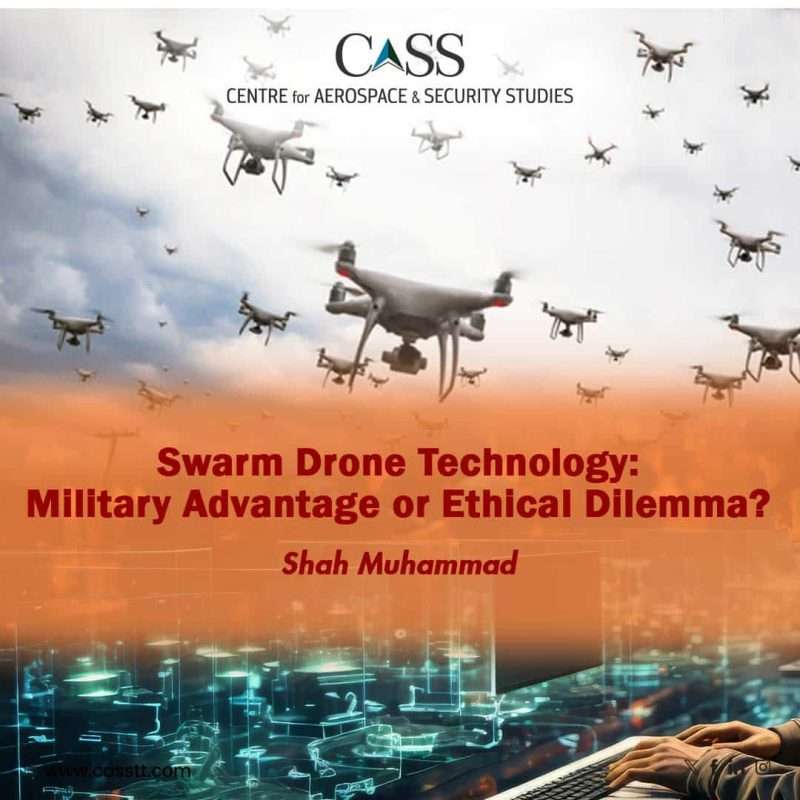Nature is reflective of the fact that the deficiencies of a single individual are often compensated for by coordinated group efforts, as seen in a pack of wolves, colony of bees, and flock of birds, etc. Rapid advancements in military technologies have materialised this natural phenomenon through the development of swarm drone technology. Swarm drones are ‘multiple unmanned systems capable of coordinating their actions to accomplish shared objectives.’ They form a cohesive unit while exhibiting advanced features of autonomy, coordination, scalability and redundancy. Thus, their ability to mutually communicate and execute missions synergistically distinguishes them from a group of individual drones. Although the technological superiority offered by these cutting-edge machines could translate into a military advantage for countries, the ensuing challenges associated with autonomous swarms necessitate careful analytical dissection.
As per a US government 2023 report, swarm drones can range from a mere three units to a cluster of thousands, enabling them to perform functions with varying levels of human intervention. The report goes on to elucidate three levels of autonomy. Centralised control is the basic level wherein human operators control and monitor each drone in the swarm. Decentralised control is mid-level mechanism wherein the human operator sends the signal but the swarm interacts with each other through a limited degree of autonomy. Lastly, the advanced level requires Artificial Intelligence (AI) augmentation for a fully autonomous swarm that accomplishes its mission without any need for human intervention.
Being technologically advanced, swarm drones can perform a wide array of tasks pertaining to air power and defence. They can spearhead electronic warfare to jam and disrupt enemy’s radar systems. These capabilities could enable them to conduct multiple long-range precision strikes, paving the way for manned aircrafts. Additionally, swarms possess greater manueverability and intelligence gathering capability. The Wall Street Journal recently reported that swarm drones could have significant ramifications for the balance of military power in today’s battlefields. In essence, these aerial machines epitomise a technological breakthrough for countries to gain significant advantage with regards to all levels of warfare.
Greater strides in swarm drone technology are being undertaken by countries like the United States (US), China, Russia, India, United Kingdom (UK), Israel and Turkey. Israel has taken the lead globally through its Legion-X drone swarm, while being the first country to deploy swarms in 2021 in Gaza. Starting with Low-cost UAV Swarming Technology (LOCUST) in 2017, the US is currently making significant advances in AI-augmented and multi-domain operational swarms that could be launched from aircraft, ground vehicles, submarines and ships. China is fast catching up with these developments and making substantial innovative leaps. It is developing advanced military drones, with each unit having the capability to split into six mid-air. This capability turns the drones into multiplying swarms that could overpower the enemy’s defence systems. The US and UK are reportedly looking to supply thousands of AI-driven swarm drones to Ukraine. If the deal goes ahead, Ukraine could gain considerable battlefield advantage in its longstanding war with Russia. Moreover, the US could leverage sea-borne swarm drones in its greater deterrence strategy against China in the geopolitical theatre of Asia-Pacific. Iran has also developed its own drone technology despite sanctions, but its recent attack on Israel demonstrated that UAVs deployed en masse are susceptible to sophisticated air defence systems.
However, the utility of swarm drone technology in the battlefields may be undermined by certain ethical barriers. Increasing levels of autonomy may be detrimental for International Humanitarian Law (IHL). Unlike traditional accountability of humans in warfare, it is challenging to hold these autonomous machines accountable for violation of IHL principles such as distinction, proportionality and military necessity. The erosion of accountability in the battlefield could undermine the legal basis of IHL. Moreover, there is an acute possibility that terrorist organisations could also get their hands on such technology. Consequently, these machines could enable non-state actors to tip the scales of asymmetric warfare in their favour. Considering their advanced autonomous features, electronic warfare has substantially raised the susceptibility of swarms. Actors engaged in hostile electronic warfare could manipulate the algorithmic characteristics of swarms and, subsequently, instrumentalise these as a potent tool for hostile attacks.
Hence, while swarm drones have rapidly become a dominant facet of the militarisation of technology in contemporary times, the military advantage offered by these machines is constrained by multiple ethical barriers. Thus, there is a need for comprehensive global policy and regulatory approaches. Both states and international organisations should undertake efforts to enhance the legal adaptability of IHL to swarm drones and autonomous military technologies. Effective regulatory oversight, along with proactive law enforcement could preclude the likelihood of non-state actors taking control of this technology. Lastly, greater Research and Development (R&D) prowess coupled with seamless institutional coordination is required to build cyber defences against the potential sabotage of swarms.
Shah Muhammad is a Research Assistant at the Centre for Aerospace & Security Studies (CASS) in Islamabad, Pakistan. He can be reached at [email protected].





